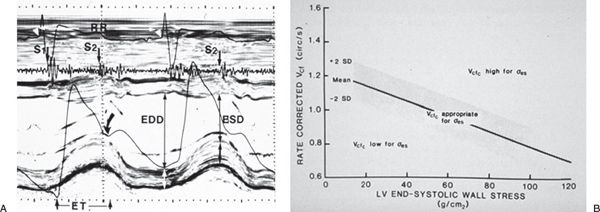
These are measured from endocardial border to endocardial border (known as leading edge to leading edge) (2) from an M-mode tracing of a transgastric short-axis (TG SAX) view taken just above the papillary muscles ( Fig. The measurements required for this quantitative estimate of systolic function are LV internal diameter at end diastole (LVIDd, also called end diastolic diameter LVEDD) and LV internal diameter at end systole (LVIDs, also called end systolic diameter LVESD). B: Measurements made for the calculation of endocardial fractional shortening may also be used to calculate end diastolic volume, end systolic volume, and ejection fraction using the Cubed (Teichholz) formula. LVIDd, left ventricular internal diameter at end diastole LVIDs, left ventricular internal diameter at end systole LV, left ventricular. Normal values: Men 25% to 43%, women 27% to 45% (1).įIGURE 3.1 A: Transgastric mid short-axis view demonstrating M-mode measurements of ventricular cavity dimensions in systole and diastole using the leading edge to leading edge technique. Linear measurements are preferably made from M-mode tracings, because the higher pulse rate compared to 2D provides better temporal resolution. Linear measurements (whether made from motion mode or two-dimensional images) have the lowest interobserver variability as compared to area or volume measurements, render quite accurate estimates of systolic function in healthy subjects, but are probably the least representative of overall LV systolic function in cardiac diseases that produce regional abnormalities of the myocardium. Quantitative Evaluation of Left Ventricular Systolic Function-Linear Measurements Consequently, calibrated measurements are preferred, and the ASE recommends that even experienced echocardiographers regularly cross-check qualitative evaluations against calibrated measurements (1).

However, accuracy and reproducibility are dependent upon the individual interpreter’s skill and interobserver measurements may vary considerably. A normal ejection fraction is equal to or greater than 55% for both men and women.Īn echocardiographer may become quite efficient and accurate at visually estimating left ventricular ejection fraction (LVEF).

Where LVEDV is LV end diastolic volume and LVESV is LV end systolic volume. Ejection fraction is expressed mathematically as a fraction of a diastolic dimension minus the corresponding systolic dimension divided by the original diastolic dimension, where this dimension can be a linear measurement, an area, or a volume. There are a number of parameters which describe LV systolic function, the most commonly used being ejection fraction. LV systolic performance may be assessed qualitatively or quantitatively with echocardiography. Quantitative Measures of Left Ventricular Systolic Performance LV thickness or mass is also usually reported with systolic function and LV chamber size to complement the overall estimate of LV systolic performance. Consequently, the preload status at the time of the examination is frequently reported along with the systolic function as the LV chamber dimension either as a diameter, area, or volume. This is not usually clinically feasible and true load-independent assessments of LV systolic function are difficult using echocardiography. Therefore, contractility or systolic function is load dependent and strictly speaking, should be assessed over a range of preload and afterload.

Contractility of the myocardial fibers of the heart is described by the Frank–Starling relationship whereby increases in preload (left ventricular end diastolic pressure ) result in increased contractility. LV systolic function describes the contractility of the LV. WHAT IS LEFT VENTRICULAR SYSTOLIC FUNCTION? The American Society of Echocardiography (ASE) recommends that every complete echocardiographic examination should include the evaluation of LV chamber size and function and emphasizes the importance of these measurements for clinical decision making (1). Left ventricular systolic performance is usually assessed in practically every echocardiogram, even if it is not the primary focus of the examination. O F ALL THE INDICATIONS FOR echocardiography, the evaluation of left ventricular (LV) systolic function is perhaps the most common in part because it is not only the best understood parameter of cardiac function but also because it has consistently been shown to be a predictor of morbidity and mortality. Left Ventricular Systolic Performance and Pathology


 0 kommentar(er)
0 kommentar(er)
